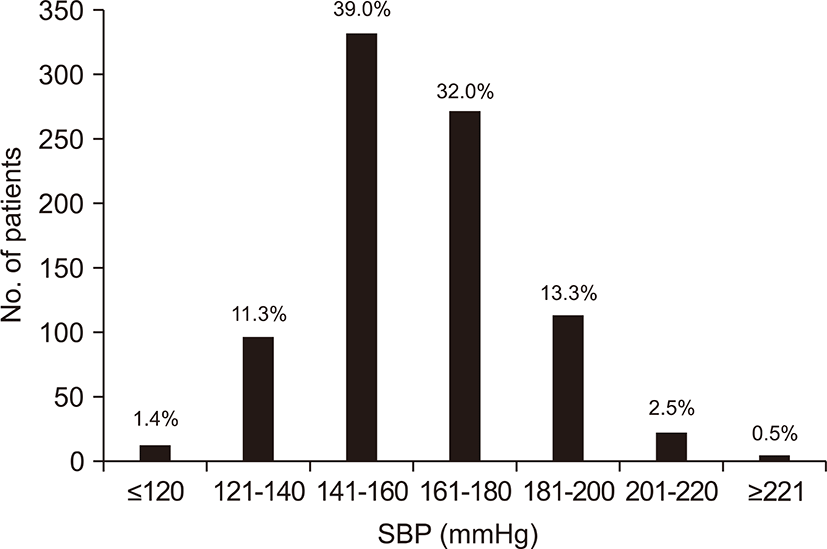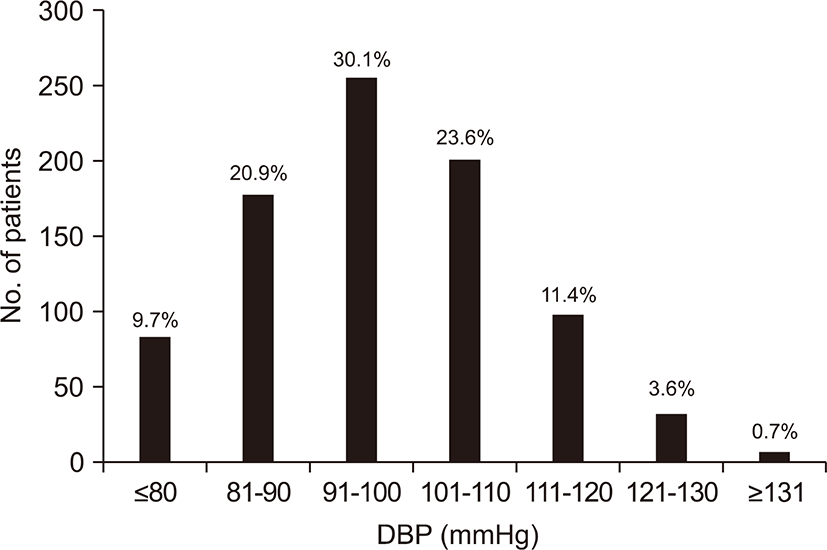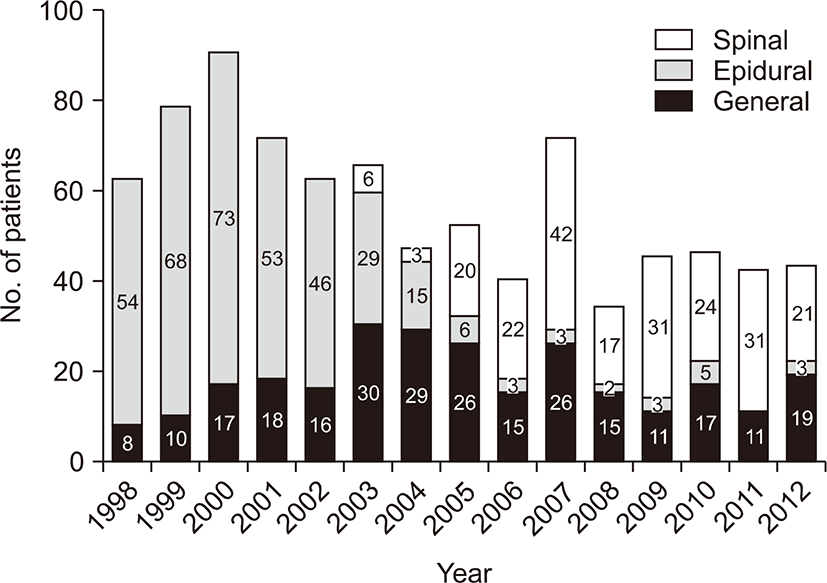Introduction
Hypertensive disorders are one of the most common medical complications of pregnancy and occur in 5% to 10% of all pregnancies [1]. Hypertensive disorders in pregnancy (HDP) are the second leading cause of maternal mortality in the United States, accounting for 15% of the maternal mortality [2]. Despite of many researches, the mechanism of hypertension during pregnancy, particularly preeclampsia, remains unknown [3,4]. Although HDP such as preeclampsia and eclampsia is not an indication of cesarean section, many HDP patients tend to have cesarean deliveries for safe management of mother and neonate. Therefore, it is important to know the pathophysiology and management of HDP for anesthesiologists. The proper anesthetic method of HDP patients has been controversial.
In South Korea, there were not enough data about anesthetic management for cesarean section of the patients with HDP. We retrieved the medical records of women who had HDP and cesarean delivery during the period of 15 years. This study compared the clinical data and maternal and fetal outcomes according to the anesthesia (general vs. regional).
Methods
This retrospective study was conducted after obtaining approval from the Hospital Clinical Research Ethic Clinical Board of CHA university. We retrieved the medical records of women with HDP who had cesarean section from January 1998 to December 2012. We included all of the patients with hypertension.
We collected the data on the prevalence rate of HDP, the rate of cesarean section, and anesthetic method. Other various data were collected from chart review. The frequencies of use of magnesium sulfate (MgSO4) and antihypertensive drugs were inspected.
The patients were classified into two groups, general anesthesia (GA) group and regional anesthesia (RA) group. Anesthesia time, operation time, 1 minute and 5 minutes Apgar scores, neonatal birth weight and neonatal death rate were compared between GA and RA group. Intraoperative uses of antihypertensive drugs (labetalol, esmolol, or hydralazine), vasopressors (ephedrine or phenylephrine), or supplementary uterotonics (methylergometrine maleate, carbetocin, prostaglandin E, or sulproston; Oxytocin was routinely administered.) was analyzed according to the method of anesthesia. We reclassified the patients in two groups according to use of MgSO4, and compared anesthetic method, blood pressure, maternal gestational age, Apgar scores, and neonatal birth weight between MgSO4 and non MgSO4 group.
Values were expressed as average±standard deviation, and the statistical analysis was performed using the IBM SPSS ver. 20.0 (IBM Co., Armonk, NY, USA). Unpaired t-test, χ2 test were used to examine the differences between the two groups. A P<0.05 was considered significant.
Results
Among 1,050 patients with HDP, 848 patients (80.8%) underwent by cesarean section. Only 3 patients (0.3%) had eclampsia with seizure. There was no maternal death among HDP patients for 15 years.
The average maternal age of the HDP patients underwent cesarean section was 32.6±4.2 years. The mean gestational age, mean weight and height were 35.7±2.7 weeks, 72.9±10.9 kg, and 160.4±5.2 cm. Table 1 shows the indications of cesarean section of HDP patients. Preeclampsia/eclampsia was the most common indication of cesarean section (36.2%). Multiple pregnancy (16.2%) and previous cesarean section (11.3%) were the second and third most common indications. Six hundred and forty two patients (75.7%) were underwent emergency cesarean section and 206 patients (24.3%) presented for elective cesarean section. Mean preoperative systolic/diastolic pressure and heart rate were 150.7±17.7/95.9±12.7 mmHg and 82.8±11.5 beats/min, increased at operating room to 163.1±19.8/98.8±12.9 mmHg and 88.9±15.6 beats/min. Fig. 1 and 2 show the distribution of preoperative systolic and diastolic blood pressure of patients. In the case of systolic blood pressure 141~160 mmHg accounted for 39.0% and 161~180 mmHg accounted for 32.0%. In the case of diastolic blood pressure 90~100 mmHg and 101~110 mmHg accounted for 30.1% and 23.6%. MgSO4 was administered to 383 patients (45.2%) in perioperative period, 327 patients (38.6%) took antihypertensive medications preoperatively.
Epidural, general, and spinal anesthesia were performed in 363 patients (42.8%), 268 patients (31.6%), and 217 patients (25.6%), respectively. The ratio of general vs. regional anesthesia was 268 (31.6%) vs. 580 (68.4%). Spinal anesthesia began to be performed from 2003 and replaced epidural anesthesia recently (Fig. 3). In the comparison between GA group and RA group, there were no significant differences in duration of anesthesia, operation time, 1 minute and 5 minutes Apgar scores, birth weight, and neonatal death rate between two groups, except estimated blood loss (Table 2). In RA group, 143 patients (24.7%) were administered vasopressors, but in GA group, only 15 patients (5.6%) were administered vasopressor (P=0.000). Significantly more patients (212, 79.1%) in GA group were injected antihypertensive drugs than the patients of RA group (18, 3.1%; P<0.001). There was no significant difference in the use of supplemental uterotonics between two groups (Table 3).
Eighty two patients (21.4%) were treated under GA and 310 patients (78.6%) under RA in MgSO4 group. In non MgSO4 group, 184 patients (39.6%) had GA and 281 patients (60.4%) had RA. In MgSO4 group the incidence of RA is significantly higher than GA (P=0.000) (Table 4). In MgSO4 group, systolic and diastolic blood pressure were significantly higher than non MgSO4 group (P<0.001 and P=0.001), and 1 minute Apgar score was lower (P=0.010) and maternal gestational age and birth weight were less than non MgSO4 group significantly (P=0.023 and P=0.010) (Table 5).
Discussion
Hypertension in pregnancy is a broad spectrum clinical diagnosis that is categorized into four types. (1) Gestational hypertension: transient hypertension of pregnancy if preeclampsia is not present at the time of delivery and blood pressure returns to normal by 12 weeks postpartum or it progresses chronic hypertension. (2) Preeclampsia/eclampsia: pregnancy-specific syndrome usually occurs after 20 weeks’ gestation. It is determined by increased blood pressure wih proteinuria. Eclampsia is defined as the occurrence in a woman with preeclampsia of seizure. (3) Chronic hypertension: hypertension that is present and observable before pregnancy or that is diagnosed before the 20th week of gestation. (4) Preeclampsia superimposed on chronic hypertension: preeclampsia may occur in women who are already hypertensive [2,5]. This study included all of the patients with hypertension during the period of pregnancy because we could not categorize the subjects into specific types of hypertension due to limitation of medical record.
The prevalence rate of HDP differs from races or genetic factors. The incidence of preeclampsia is 2.5~7.0%, but it tends to decline in advanced countries [6,7]. In Korea, it was reported that the prevalence rate of pregnancy induced hypertension decreased from 5.24% to 3.94% [8]. In our study, the incidence of HDP was 1.5% of total deliveries which was much lower than other previous studies. The reasons can be thought as relatively high socioeconomic status of our patients and good antenatal care.
Vaginal delivery is the primary choice for preeclampsia to avoid the risks of cesarean section [2,9,10]. However women with preeclampsia have an increased rate of cesarean section due to high incidence of intrauterine growth restriction, fetal distress, and prematurity [5]. In Korea, the cesarean section rate of HDP patients was reported 57.9% [8], it was 80.8%, much higher than previous studies in Korea. The reasons of increased incidence of cesarean section in HDP are high rate of emergency operation due to hypertension and its complications, increasing elderly pregnancy, and scheduled cesarean section by patient’s requirement. High incidence of multiple pregnancy contributed to increase the cesarean section rate of HDP patients.
There have been controversies about the proper anesthetic method in hypertensive parturients for cesarean section. The risks of GA, especially hypertensive response to intubation, can be avoided by RA. So there are minimal indications of GA: coagulopathy, pulmonary edema, eclampsia, and fetal distress [11,12]. In the past, spinal anesthesia was contraindicated in patients with severe preeclampsia because it could induce severe hypotension and placental hypoperfusion [13]. However, many clinical studies proved that spinal anesthesia could be performed safely in the cesarean section for severe preeclampsia patients [14-16], and the incidence of hypotension and ephedrine requirement were lower than healthy parturient group [17,18]. In one previous study spinal anesthesia was reported to be more favorable choice of anesthesia than epidural anesthesia because of quality of analgesia and time efficiency even though both of them did not induce severe hypotension and neonatal depression in preeclampsia [19]. Recently, spinal anesthesia became a major anesthetic technique for the cesarean section of HDP patients in our hospital, and it is preferred to obstetricians because it offers the advantage of rapid onset and complete muscle relaxation. In our results, there was no significant difference in maternal and neonatal outcome between general and RA group. Intraoperative bleeding was more in GA than in RA, which might be result from higher blood pressure in GA.
The only definitive cure of preeclampsia/eclampsia is delivery of fetus and placenta. So the aim of conservative treatment during pregnancy is to prevent and control clinical manifestations. The therapeutic goals are prevention of seizure, control of hypertension, maintenance of maternal hemodynamic stability, and optimization of intravascular volume [3]. MgSO4 is the drug of choice for seizure control, it suppresses central nervous system mediated by N-methyl-D-aspartate receptors and also suppresses peripheral nervous system. It is used to improve blood supply of uterus by depressing uterine hyperactivity. It has mild vasodilation effect [2,3]. Incidence of eclampsia was increased in mild preeclampsia who were not administered MgSO4 [20]. In patients received MgSO4 (45.2% of total), 78.6% underwent RA, 1 minute Apgar score was lower and maternal gestational age and neonatal birth weight was less than in patients without MgSO4. Coeffect of magnesium, anesthetic agent and muscle relaxant may cause neonatal depression. Also the patients administered MgSO4 might tend to have more severe preeclamsia and less gestational age, so it could affect neonatal prognosis continuously.
The incidence of HDP is decreasing in Korea. However there are still many difficulties in anesthetic management of women with HDP. Anesthetic methods did not have significant effect on outcome of cesarean section of the patients with HDP. Therefore anesthesiologists must have much attention on the prevention, treatment and anesthetic management for cesarean section of patients with HDP regardless of anesthetic method. Limitation of this study was that our subject group could not represent Korean population due to locational characteristics, so multicenter study is needed in the future.




